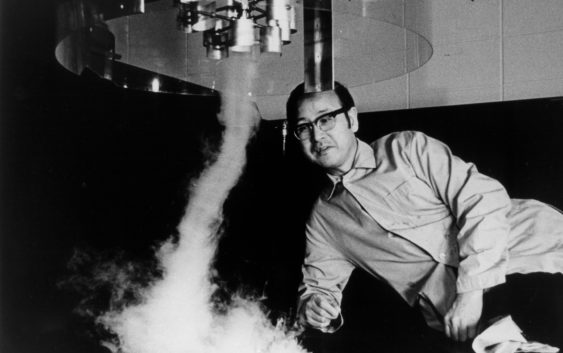- The Texanist: Texas Gets More Tornadoes Than Any Other State, but Don’t Freak Out
- U.S. Supreme Court says Texans can sue state for flood damage
- This is how many hurricanes NC State researchers predict this year
- NC State researchers predict above-average hurricane season
- Supreme Court rules in favor of property owners suing Texas over flood damage
Caprock Chronicles: Ted Fujita, tornados, Lubbock, & Texas Tech

Caprock Chronicles is edited each week by Jack Becker a Librarian at Texas Tech University Libraries. This week’s article is by Dr. Richard Peterson, professor emeritus, atmospheric science. He relates how Professor Ted Fujita developed the F-scale to measure the destructive power of tornadoes using information he collected after Lubbock’s 1970 tornado.
Almost half a century ago, Lubbock was struck by one of the most significant tornadoes in history. But for the city, the tragedy was quickly followed by renewal. The death toll was 26, and devastation amounted to the greatest dollar damage in US history up to that that time.
The outstanding character of the tornado damage led to the formation at Texas Tech of the Institute for Damage Research (IDR). Three young civil engineering professors and their Chair began a program of research and teaching, which continues to lead the Nation in the study of tornadoes, hurricanes, as well as wind energy.
News of the Lubbock tornado brought the world’s leading tornado researcher, Dr. Ted Fujita from the University of Chicago to investigate. His analysis quickly resulted in two major advances in the study of tornadoes: establishment of a tornado intensity rating (F-scale) and the concept of multiple-vortex tornadoes.
Over the years, Texas Tech faculty and students worked closely with Fujita to refine and extend his concepts. After Fujita’s death, his unique research materials were offered to Texas Tech, and are now housed in the Southwest Collection.
Tetsuya “Ted” Fujita was a native of Japan and trained as an engineer before he served in the Japanese air force during World War II. After the war, he obtained a doctoral degree in meteorology and began to make his own analyses of storm events.
At this time, meteorologists at the University of Chicago led a ground-breaking study of thunderstorms in the US. Through an amazing stroke of luck, they became aware of the analytical skills of Fujita. He was brought to the University, and the direction of severe storms research was indelibly altered.
The University of Chicago Thunderstorm Project resulted in the concept of the three-stage development of non-severe thunderstorms. Later, Fujita moved to Oklahoma to study severe weather under the auspices of the National Severe Storms Laboratory in Norman. The Storm Lab in Norman used a dense network of surface weather stations across the southwest quadrant of the state, which preceded the West Texas Mesonet System established by Texas Tech.
When the first meteorological satellite, TIROS, improved weather photographs in 1962, Fujita and his staff developed methods to render the pictures usable. After problems with the satellite images were rectified, Fujita’s study of severe thunderstorms advanced.
In the late 1950s and into the ‘60s there were several notable tornado events that drew Fujita’s attention. The National Severe Storms Forecast Center (NSSFC) in Kansas City had begun issuing storm advisories: severe storm and tornado watches and warnings.
The NSSFC had for years published storm data in the publication, Storm Data. Using this data, Allen Pearson, director of the NSSFC, and Fujita developed a tornado classification system. The intensity part of the scale, the F-number, was to be based on the appearance of the damage.
Fujita assembled pictures for each F-number, one through six, and provided a range of probable wind speeds for each. The wind speeds became commonly referred to in the media and were subject to some controversy among researchers. Decades later under the leadership of Texas Tech researchers, the Fujita scale was re-evaluated, yielding an enhanced scale, the currently cited EF number.
Fujita found a pattern of damage in the swath produced by the Lubbock tornado which had been seen previously but which remained unexplained. In the wide damage path, there were areas of intense destruction. It had been speculated that the tornado dragged a large object in its path, tearing down obstacles as it went.
Fujita proposed that the responsible feature was a smaller vortex formed within the major tornado and which intensified the damaging winds in a cyclic pattern.
The third major concept introduced by Fujita came from the analysis of catastrophic plane crashes in the vicinity of thunderstorms, beginning with an Eastern Airlines jet, which crashed near JFK Airport. A careful analysis of multiple flight data revealed the nature of the thunderstorm winds responsible for this and other crashes.
The evaporation of intense falling rain produces a strong downdraft, which spreads upon nearing the ground. This creates an unexpected shift and intensification of winds as the jet slows down and descends. The jet is essentially slammed to the ground by what Fujita termed a downburst (later microburst).
This aspect of thunderstorms is extremely common. While they can be observed visually, their small size generally precludes detection from weather stations. Fujita’s analysis was a major factor in Congressional approval for the current nationwide Doppler radar (NEXRAD) system.
Fujita continued his researched into other weather phenomena (e.g., hurricanes and drylines), but his lasting contribution into the study of weather rests on three conceptual advancements: the EF scale, multiple-vortex tornadoes and microbursts.